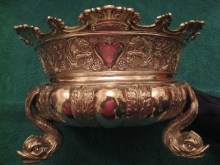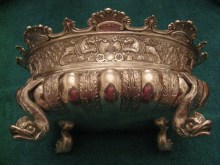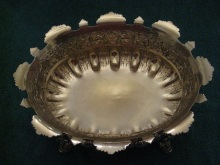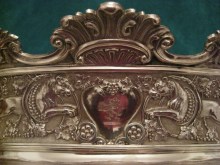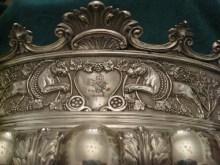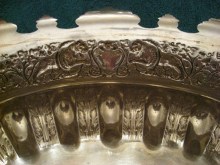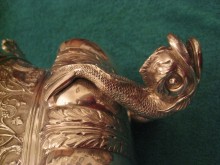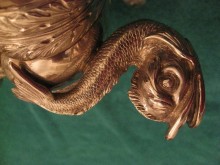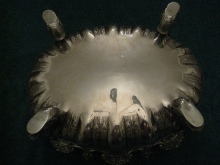by Alan
Yates
|
click on images to enlarge
AN UNMARKED MONTEITH
The above item was purchased recently at the Olympia Arts
and Antique Fair. It is a superb piece, in excellent condition,
but unmarked. It was described as 'Silver Bowl. Gilt inside. London, ca
1830. Unmarked'.
It is 32 cm across and weighs 2 kgs (70 oz).
I visited the V & A the following day but could find nothing
in the silver collection to assist me to identify it. A very
helpful member of staff suggested that I forward images for assistance to the curator
of the Silver Dept. of the V&A Museum.
This is the comment kindly formulated by the Curator of V&A
Museum:
".... Thank you for your enquiry regarding your spectacular
silver purchase.
It is an eclectic mix and I would agree that ca. 1830 would be
an appropriate date. The dolphin feet hark back to the early
18th century, as does the embossed bowl and shell border but the
elaborate band of lions and vines suggests the early 19th
century. The first silversmith that comes to mind when
discussing this type of work is Edward Farrell who worked for
the Duke of York producing outlandish coolers and candelabra for
the royal dining table. Some examples of his work are at the
following link.
http://www.vam.ac.uk/collections/metalwork/temp_displays/audrey_love/index.html
Farrell's work was influential and contributed towards the
flamboyant testimonials and racing trophies presented later in
the 19th century. Your bowl may well be by someone who had seen
Farrell's work.
Its small size suggests it probably was not a wine cooler - the
prominent u-shaped recesses on the shell border lip make me
wonder if it is in fact a monteith for cooling glasses. I think
it is probably English although the lions have a slightly
eastern elongation to them.
It is unusual that the object is not marked - perhaps it was
meant as a sample and not for retail...."
I also rather like the possibility of Edward Farrell being the
maker but I'm not convinced. Although the interior is gilt, the
three joins (between bowl and 1/2 " concave band, concave band
and repousse band of lions, and band of lions and shell border
lip) are not well done on the interior of the piece, especially
the lowest joint. There are also four vertical joins in the band
of lions - again noticeable from the inside - at each of the
four cartouches (both sides and both ends).
There is a crest in the two side cartouches comprising a lion
rampant with cross between front paws. Both end cartouches are
vacant.
I have searched the 'band of lions' for evidence of erased marks
but to no avail. I mention this because I am concerned that the
article may in fact be a made-up piece.
The item comes from the Olympia Arts and Antique fair of this
year. It was described as London ca 1830.
But have you or any other member ever seen another piece of
unmarked Regency silver?
I suggest not. Hence the mystery.
Any suggestion, addition or comment will be highly appreciated.
|
Alan Yates
- 2009 -
|
|
 ASSOCIATION OF SMALL COLLECTORS OF ANTIQUE SILVER
ASSOCIATION OF SMALL COLLECTORS OF ANTIQUE SILVER